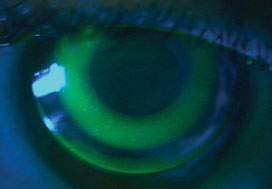 |
For bilateral myopic anisometropes, here, we found that the relative corneal refractive power shift could capture around 7% of the variance observed in AL growth whether in more myopic eyes or in less myopic eyes. Photo: Julie Tyler, OD, and Heidi Wagner, OD, MPH. Click image to enlarge. |
Orthokeratology (ortho-K) has been reported as an effective tool for managing myopic anisometropia. It has been shown to correct interocular differences in refractive errors and slow axial growth in both eyes compared to wearing single-vision spectacles. However, no prior study has analyzed the possible influencing factors accounting for the different axial length (AL) growth in two eyes of anisometropic children following treatment. A collaboration between researchers in China and the College of Optometry of Nova Southeastern University in Davie, FL analyzed the between-eye differential axial growth in anisometropes wearing ortho-K lenses and examined its association with the difference in relative corneal refractive power shift. The team found that the interocular difference in AL growth in the ortho-K group was significantly correlated with the interocular difference in relative corneal refractive power shift (and the interocular difference in baseline AL. In children with myopic anisometropia treated with ortho-K, AL growth in the relatively less myopic eyes exceeded that in the more severely myopic eyes.
The prospective interventional study randomly assigned 102 children between the ages of eight and 14 with myopic anisometropia to the spectacle group (n=41) and ortho-K group (n=61). The participants were required to wear the lenses for at least eight hours per night and at least six days per week. Follow-up visits were scheduled at one day, seven days, one month and at least once every three months afterwards. The subjects in the spectacle group were fitted with ordinary and commercially available glasses and were required to wear spectacles all day long, except for sleeping.
In the ortho-K group, the AL growth in the more myopic eye (0.06mm) was significantly smaller than that in the less myopic eye (0.15mm), and the interocular difference in AL significantly decreased following one-year treatment, from 0.47mm to 0.38mm. However, in the spectacle group, the AL growth was similar between the two eyes, and the interocular difference in AL did not change significantly over one year.
Notably, a distinct and statistically significant dose-response correlation was identified between the interocular discrepancy in AL growth and the interocular difference relative corneal refractive power shift, indicating that eyes which underwent more relative corneal power change following orthokeratology treatment would achieve less axial growth. Based on these findings, the researchers believe it may be possible to enhance the AL growth inhibition in the less myopic eyes of anisometropic children undergoing ortho-K treatment by modifying the lenses to increase relative corneal refractive power shift.
“The interocular variation in relative corneal refractive power shift is an important factor accounting for the reduction of interocular AL growth difference in anisomyopic children post-ortho-K,” the authors wrote in their paper. “These results provide insight into establishing eye-specific myopia control guidelines during ortho-K treatment for myopic anisometropes.”
Lin W, Li N, Liu J, et al. Relative corneal refractive power shift and inter-eye differential axial growth in children with myopic anisometropia treated with bilateral orthokeratology. Graefes Arch Clin Exp Ophthalmol. November 6, 2023. [Epub ahead of print]. |

